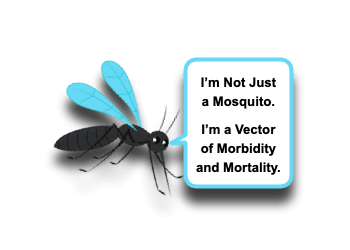Dengue Fever in Children

We know well by now that we should never say “It’s just a virus” as a way to assuage parental concerns. There are just too many viral infections that can prove to be problematic and won’t necessarily merely “go away” without causing morbidity or mortality. Eastern Equine Encephalitis, Measles, Mumps, Varicella, and Influenza come to mind… not to mention the current COVID-19 pandemic. Let us digest a morsel on another viral illness that causes a wide spectrum of illness in children – Dengue Fever:
Dengue Fever in Children: Basics
- Fun Facts you’ll likely forget (if you are like me)
- Dengue is caused by one of the Flaviviridae viruses [Rajan, 2020; Chen 2018]
- 5 different serotypes
- Either DENV1, DENV2, DENV3, or DENV4
- Vector = female mosquitoes [Rajan, 2020]
- Either Aedes aegypti or Aedes albopictus
- In case you are ever asked by an interested neighbor or appear on Jeopardy (looking at you Dr. Stephen Jackson).
- Referred to as “Break Bone Fever” due to the significant myalgia and arthralgias that are commonly present.
- Dengue is caused by one of the Flaviviridae viruses [Rajan, 2020; Chen 2018]
- Dengue is a significant public health problem globally. [Rajan, 2020; Chen 2018]
- Most common in tropical and subtropical regions.
- Endemic to more than 100 countries.
- Tropical Asia, Central and South America, and the Caribbean.
- Travel makes it possible anywhere (gotta love the international airport in Charlotte!).
- It is the most prevalent systemic viral infection transmitted by mosquitoes!
- Most common in tropical and subtropical regions.
- Dengue affects both adults and children. [Rajan, 2020]
- Adults tend to be more symptomatic.
- Children can be asymptomatic or have milder symptoms (hmmmm… what else does this sound like?).
Dengue Fever in Children: Clinical Spectrum
- Dengue is difficult to distinguish from other viral illnesses. [Rajan, 2020; Kularatnam, 2019; Chen 2018]
- No pathognomonic clinical clue.
- PCR or Non Secretary (NS) 1 antigen testing within first 48 hours can be used to diagnose illness.
- Clinical spectrum may be reflected by laboratory abnormalities. [Kularatnam, 2019; Chen, 2018]
- Low WBC count on days 2-7
- Low Platelet counts on days 4-7
- Higher aPTT on day 2
- Only clue may be in the history – recent travel or exposure.
- Dengue’s spectrum of disease ranges from asymptomatic to overt shock. [Rajan, 2020; Kularatnam, 2019; Chen 2018; Soni, 2001]
- Large spectrum likely related to both different viral and host factors.
- Dengue Fever is a benign, self-limited disease.
- Dengue Hemorrhagic Fever, on the other hand, can be fatal.
- Common symptoms: [Chen, 2018; Badreddine, 2017]
- Acute fever (2- 7 days)
- Headache, Retro-orbital Pain
- Arthralgia, Mylagias, Bone Pain
- Rash, Petechiae
- Abdominal Pain, Nausea, Vomiting, Diarrhea
- Typical classifications include:
- Asymptomatic and / or Mild Febrile Illness
- Classic Dengue Fever (DF)
- Dengue Hemorrhagic Fever
- Dengue Shock Syndrome
- Large spectrum likely related to both different viral and host factors.
- Dengue Hemorrhagic Fever Grading [Soni, 2001]
- Dengue Fever
- Fever with 2 or more (Headache, Retro-orbital pain, Mylagia, Arthralgia)
- Low WBC counts may be seen.
- Dengue Hemorrhagic Fever (DHF) I
- Above criteria with + Tourniquet Test (petechiae noted after BP cuff inflated)
- Labs: Plus < 100,000 platelets, Hct increase of 20%
- DHF II
- Above criteria with Spontaneous Bleeding
- Labs: Plus < 100,000 platelets, Hct increase of 20%
- DHF III
- Above Criteria with evidence of circulatory impairment.
- Weak pulse, cold extremities, restlessness, Cap Refill > 2 sec.
- DHF IV = Overt Shock.
- Dengue Fever
Dengue Fever in Children: Management
- There is no specific treatment against the viral infection. [Rajan, 2020; Kularatnam, 2019; Chen 2018; Soni, 2001]
- Recognition that Dengue is a Dynamic illness is important as patients need to be reassessed over the course of the illness to ensure no progression to worse stages is occurring. [Chen, 2018]
- Symptomatic and supportive management is key.
- Milder cases need to have symptoms monitored for progression of illness.
- Oral hydration therapy needs to be emphasized and optimized.
- Initial labs:
- CBC – looking specifically for thrombocytopenia and hemo-concentration
- Renal Function Panel
- Coagulation Panel
- Liver Function Panel
- Those with Dengue Hemorrhagic Fever and/or Shock requires:
- ICU level care for close serial exams and testing.
- Management of significant volume losses, but in setting of hypoproteinemia and propensity for 3rd spacing of fluids.
- Correction of electrolyte and metabolic derangements.
- Management of Disseminated Intravascular Coagulopathy.
- Management of overt Sepsis.
- Milder cases need to have symptoms monitored for progression of illness.
Moral of the Morsel
- Mosquitoes Suck! Viruses Suck Too! Both can be bad!!
- Consider Travel! Dengue may need to be on your Ddx list.
- Dengue is Dynamic. If the patient looks good today, she/he still need to be reassessed in the coming 24-48 hours to ensure there is not progression to hemorrhagic stages.
- Look under the Blood Pressure Cuff! Is that a +Tourniquet Sign you see there?
- Support! It may be simple or it may be complex, but supportive care is what they need.

